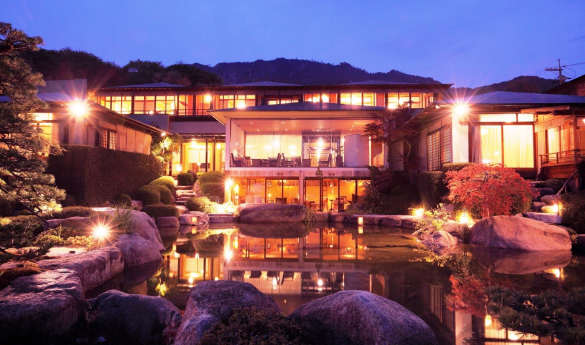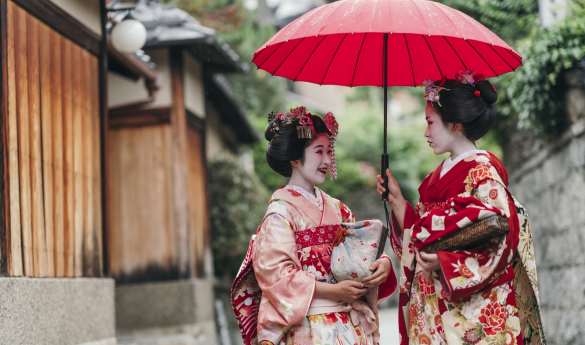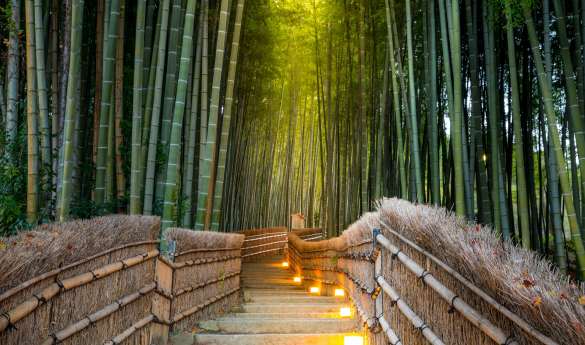Japanese Cuisine: A Guide to Famous Foods in Japan
Get to know your ramen from your udon on a culinary adventure through Japan.

From north to south, Japanese cuisine varies greatly - so if you’re a foodie looking for a taste of adventure - you won’t be disappointed with the eclectic array of food in Japan.
Food culture in Japan
As you might imagine, the food culture of Japan is incredibly unique and important to its citizens, and no doubt a key draw in travelling there too.
If you love fish, you won’t be disappointed - unsurprisingly sushi reigns supreme here - but for meat lovers, there are more than enough delectable dishes to sink your teeth into, including Wagyu beef and pork gyoza.
For the Japanese, a meal goes beyond just eating. It is a practice in which people can socialise, build stronger bonds, and come together as one. For the religious, it’s also a way to thank the gods through rituals.
Typically, a meal in Japan will be made up of a number of seven main components. These are:
- Rice
- Noodles (ramen, soba, somen, and udon)
- Vegetables including sea vegetables and daikon radish
- Soy (soy sauce, tofu, miso ,edamame)
- Fish such as salmon, mackerel
- Green tea
- Fruits, like tangerine, persimmons and Fuji grapes
One of the most authentic ways to eat Japanese cuisine is tucking into a ten course Kaiseki banquet in the comfort of a ryokan. These traditional Japanese inns are a wonderful insight into olden day Japan and the food served is an incredible testament to the timelessness of Japanese cuisine, its age-old traditions and unique customs.
Dish after impeccably presented dish is brought to your table, fusing the flavours of Japan old and new, and they are all washed down with sake. What’s not to love?
Japan expert and Senior Travel Consultant Rikki Poynton agrees:
“For me, staying in a ryokan and experiencing a traditional Kaiseki dinner is a must for anyone visiting Japan. It’s a multi-course tasting menu of lots of weird and wonderful local delicacies, served in the most stunning way. I also highly recommend a sushi breakfast, either at a low-key market stall or a high-end restaurant. A lot of the best sushi masters prepare an exceptional breakfast menu at a fraction of the cost of their dinner menus.”
Dining is often an interactive experience. From preparing your own Okonomiyaki, a DIY pizza if you will, to barbecuing your own Yakiniku, or grilled meat, getting to grips with Japan's flavours makes for a truly exciting experience.
Another cultural food tradition is to enjoy a bowl of Sukiyaba or Shabu Shabu - broths which bubble with the flavours of sake, soy and sugar and are served with beef, vegetables and noodles for incredibly fresh and flavoursome dishes you'll be vowing to recreate at home.
What is food like in Japan?
If there’s one word that sums up food in Japan, it’s eclectic.
In Japan, you can enjoy not only some of the most luxurious, five-star fine dining experiences in the world - but excellent street food too. This form of traditional Japanese food is not to be sniffed at, boasting exquisite flavours and surprising textures, it’s definitely worth enjoying during your visit.
Treat yourself to a gourmet Japanese meal in a Michelin star restaurant at Sukiyabashi Jiro, a small cosy sushi restaurant in Tokyo with only ten counter seats. Proudly awarded three stars, this restaurant was even featured in the 2011 documentary Jiro Dreams of Sushi.
Don’t forget to check out Ginza Kojyu, which serves an impressive multi-course kaiseki menu in a Zen-like dining room.
Outside of Tokyo, pay a visit to Kyoto Kitcho Arashiyama and tuck into delectable cuisine of impeccable presentation while enjoying the scenery of a beautiful bamboo garden.
When in Osaka check out Hajime, one of the top 50 restaurants in the world that proudly carries the theme of ‘beauty of nature’, which you can observe in dishes that are tastefully crafted to resemble ponds, swimming koi, and more - they’re almost an art form.
If you’re heading to Tokyo, the Mandarin Oriental is a mecca for food lovers. Offering unforgettable vistas, incredible dining experiences and no less than three Michelin-starred restaurants, this hotel is a true treat for the taste buds. Whilst fine dining options are in abundance in Tokyo, and indeed elsewhere in Japan, particularly in the city’s many luxurious hotels, some of the best eateries are to be found in the most unassuming of places.
In a subway station, look out for a hubbub surrounding popular street vendors. A long queue is a reliable starting point to find a delicious mid-afternoon snack.
Elsewhere in the city, we’d recommend a visit to the unmissable Tsukuji fish market - one of the largest and most historical fish markets on earth. Here, you’ll be rewarded with some of the world’s best seafood in the outer market.
Our top tip for dining out in Japan? Bear in mind that restaurant reservations are notoriously hard to get hold of, so booking in advance is crucial to secure sought after tables. If you’re booking a luxury Japan holiday with us, our friendly travel consultants can happily help book things for you for peace of mind; just let us know the details and we’ll take care of it.
No matter where in Japan you are, the endless choice of dining options, from street eats to fine dining, hold the key to unlocking the secrets of sushi, sashimi and soba. It’s truly a part of Japanese culture that you won’t want to miss.
Famous Food to Try in Japan
There are many, many delicious foods in Japan, but here are some of the most popular dishes we’d highly recommend that you try.
Sushi
Chances are, you’ll have tried this famous Japanese dish at some point in your life, or, you may even be a total sushi aficionado. Either way, sushi is one of the most famous foods in Japan, so much so that it’s considered an art form in certain circles.
Sushi comprises mostly of raw fish and seafood or vegetables (though some meat varieties do exist), with some of the most popular being maguro (tuna), shake (salmon) and unagi (freshwater eel).
Sashimi and maki are popular types of sushi, delicious with a dip of soy sauce. Sushi is typically eaten with rice, ginger, soy sauce and wasabi, and washed down with a glass of warm sake!
Noodles (ramen, soba, udon, somen)
Noodles are a mainstay of Japanese cuisine and form the basis of many dishes, including ramen and stir frys.
The four most common types of noodles are:
- Ramen
- Soba
- Udon
- Somen
They tend to come in different textures and thicknesses, and can be made from rice, buckwheat, wheat or even potato starch. Yakisoba, tonkotsu ramen and miso ramen are some of the country’s most famous noodle dishes and are great introductions into Japanese cuisine.
Wagyu beef
If you’re a meat-lover looking to sample some of Japan’s traditional food, Wagyu beef is considered a real specialty. It’s also of the highest quality, and pretty rare, making it a high-end dish during an evening out.
So what’s so special about Wagyu beef?
Essentially, it contains a higher percentage of omega-3 and omega-6 fatty acids and more monounsaturated fats than other types of beef. Once heated, this results in a deliciously soft and buttery texture but also incredible flavours.
If you’re looking for a must-try luxury dish to sample while holidaying in Japan, this has got to be it.
Whilst we’re on the subject of beef, Matsusaka beef is another Japanese speciality - coming from the meat of Japanese black cattle reared in strict conditions in the Matsusaka region of Mie in Japan. This high fat content meat when cooked is so tender it practically melts in the mouth.
Miso soup
This traditional Japanese soup is a simple, but tasty staple that’s served as part of many set meals in Japan. Sometimes it’s enjoyed as a starter, sometimes at the end of a meal, but it can also be drunk as part of a light lunch.
Typically made with miso paste, tofu, vegetables, dashi and sometimes seafood, it’s not only full of flavour, but is nutritionally beneficial for you too, rich in nutrients and antioxidants.
Teppanyaki
Teppanyaki is more a style of Japanese cooking than a dish in itself, although the word is often used to describe the meal.
The term derives from the words ‘teppan’ - meaning iron plate - and ‘yaki’ - meaning grilled or pan-fried, so essentially, this style of cuisine means to grill food on a hot iron plate.
Foods cooked teppanyaki style can include:
- Meat
- Seafood
- Vegetables
- Noodles
Part of the joy of a teppanyaki meal is to experience it at a high-end restaurant where the chef will cook in front of you, displaying their skills and entertaining you while you eat.
Okonomiyaki
Now onto one of Japan’s most delicious street food offerings - Okonomiyaki. This savoury pancake dish is made of a wheat flour batter and any other desired ingredients, all cooked on a teppan (hot grill).
You can technically add anything you like to this delicious pancake dish, but common additions include cabbage, meat and seafood, as well as toppings such as Japanese mayonnaise, sriracha and pickled ginger.
If you’re keen to try it, head to a popular street food stand - you’ll soon see what all the fuss is about!
Yakitori
Yakitori is a type of skewered chicken, prepared by skewering meat with what’s known as a kushi - a skewer made of steel, bamboo or wood.
The chicken then gets grilled over a teppan or a charcoal fire, resulting in a delicious barbecue taste. The meat can be seasoned with salt, pepper or tare sauce (a dipping sauce made of soy sauce, sake, brown sugar and rice wine) and served with other meats and vegetables.
A simple, yet delicious dish.
Gyoza
Just like sushi, gyoza is likely a Japanese dish you’ll have tried before, as it’s often served as part of Japanese takeaway meals or in Japanese fast-food chains in the UK.
Gyoza are a type of warmed dumpling, typically filled with a mix of finely minced pork, mushrooms and cabbage and dipped in a soya-based sauce - but you’ll likely find gyoza with a variety of fillings, such as duck, chicken, or mixed vegetables.
Gyoza can be enjoyed as street food, but, as with most dishes, can be delicious when given the high-end treatment and featured on the menu of a five-star restaurant.
Japan expert and Senior Travel Consultant Rikki Poynton says:
“My personal favourite Japanese dish is Tsukemen - similar to ramen but the noodles are served separately and you dip them into a rich, usually pork-based broth. I also love Okonomiyaki topped with sweet and sour sauces, strips of bacon and bonito flakes. Delicious!”
Lesser Known Japanese Dishes
As well as its popular staples, Japan is also known for its weird and wonderful dishes, so for those of you seeking to try something different that you’re far less likely to find at home - look out for some of these delicacies:
Sea urchin
You’ll know by now that the Japanese love their seafood, and this extends even to the prickly sea urchin. This unusual dish is typically served raw and eaten as a type of sushi or as a topping to a rice dish. If you’re a first-timer trying this, be warned that these slippery sea creatures have a somewhat slimy texture and salty flavour - so you’ll either love it or hate it. If you’re interested in its health benefits though, you’ll be pleased to know that sea urchins are packed with vitamins, minerals and omega-3 fatty acids.
Natto
A protein rich, if slightly pungent choice for a snack, natto comprises fermented soybeans often topped on rice or in a sushi roll. It has a sticky/stringy texture and tastes a little like salty cheese and beans. It’s a dish you don’t often hear about, but the Japanese eat it regularly as it’s known for its health benefits, helping maintain a healthy immune system, bone health and digestive system.
Beef tongue
This lesser-known dish is best stewed so that the meat is softened and flavourful, and can be served alongside potatoes and vegetables or rice. In Japanese culture, beef tongue is often cut into thin slices and prepared on a yakiniku barbecue giving it a smoky taste and texture. It may sound a little strange, but it’s surprisingly tasty and well worth a try.
Pufferfish
Perhaps one of the most unique foods in Japan is pufferfish (or Fugu), a dish that if prepared incorrectly, can actually be extremely dangerous to eat thanks to its toxicity - so it’s definitely not one to try to cook yourself! Pufferfish tastes a lot like white fish, and is surprisingly easy to eat. So, if you tend to lean towards the daring side of food tastings, give it a go.
Raw egg on rice
Otherwise known as tamago kake gohan, this dish is often served for breakfast and makes for a great way to start your day. While you may be put off by eating raw eggs, high-quality eggs are something the Japanese pride themselves on, so it’s generally considered safe to eat them raw. Enjoy your raw eggs and rice with different vegetables, seaweed or ginger.
Shirako
This deliciously unique nibble may not hold wide appeal outside of Japan, especially since it looks a little like a brain and is in fact the sperm sac of a codfish. However, in Japanese food culture, it’s often considered a delicacy. Shirako can be enjoyed in many ways - battered as tempura, grilled, or even raw as sushi - each method offering a different texture, flavour and food profile.
Try It All With a Japan Food Tour
Keen for your Japan trip to encompass a culinary tour where you can sample some of the most popular food in Japan? Try our expert-led Taste of Japan tour.
This luxury food tour gives you the chance to explore Japan through its incredible cuisine, getting to know the country’s treasured food culture and famous dining scene.
On it, you’ll experience the practice and presentation of kaiseki dining, enjoy a sushi masterclass, sample delicious street food and learn all about Japan’s most famous drink - sake. You’ll also get to travel around Japan while you do so, spending time in Tokyo, Kanazawa, Kyoto, and Osaka.
If you’d rather experience the delights of Japanese cuisine your own way, we can recommend a number of high-end restaurants, michelin-starred venues and insider foodie spots at which you can enjoy the very best food.
Rikki Poynton recommends Tokyo’s Mandarin Oriental in particular:
“The Mandarin Oriental in Tokyo is a foodie’s paradise. It offers 12 restaurants on-site, many of which are Michelin-starred, including Sushi Shin by Miyakawa, Hokkaido’s 3* sushi. Beniya Mukayu near Kanazawa is another great option. It’s a contemporary ryokan where you can try its Kaiseki cuisine or order from the amazing a la carte menu.”
Meet our Japan specialists
Call us on 020 8682 5060 to start planning your holiday
Why Scott Dunn?
Unique to You

- We listen to your travel goals and craft unique trips that are bespoke to you.
- We’re with you every step of your life’s travel journey, from honeymoons to family trips and beyond.
Seamless Service

- Global offices in the UK, US, and Singapore for 24/7 seamless service.
- We offer flexibility if your plans change so you can book with confidence and peace of mind.
Carefully Curated Collection

- We’ve curated an elevated collection of accommodation, experiences, and guides.
- Committed to fostering close global relationships to continue bringing you unique experiences.
Luxury in Every Sense

- We deliver a sense of luxury that matters most to you.
- Awarded Condé Nast Traveller’s Top Travel Specialists in the World 12 years in a row.













